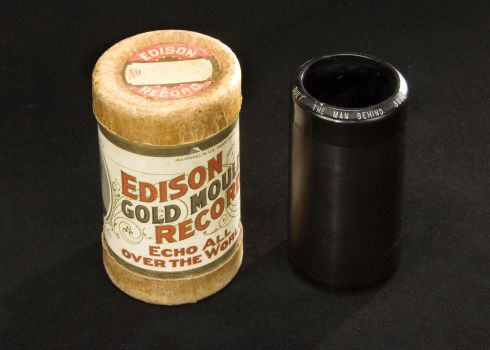Edison Gold-Moulded Cylinders (1902–1912)

By the end of the 19th century, as the limitations of brown wax cylinders became increasingly evident, Edison returned to the laboratory in an attempt to make refinements to his pioneering developments in sound recording. At that time, the standard procedure for recording brown wax cylinders was mass repetition. A performer would typically sing or play in front of a small number of horns hour after hour, with each performance yielding a small batch of cylinders. Subsequent developments in the brown wax duplication process made churning out these early cylinders easier: the acoustic dubbing method and its technologically advanced successor, the pantographic method, mitigated the necessity of the all-day performances required by those instrumentalists or singers whose tunes were in high demand. Still, the means of recording remained primitive and the quality from cylinder to cylinder was often inconsistent, with the results dependent on the number of duplication sessions involving the master cylinder, which degraded with use, and also on the recording decisions made by the engineer for any given performance.
The "Gold-Moulded" process, developed in 1902, significantly ameliorated these limitations. The process involved creating a metal mold from a wax master; a brown wax blank could then be put inside the resulting mold and subjected to a preestablished and precisely calibrated level of heat. As the blank expanded, the grooves would be pressed into the blank, and after cooling, the newly molded cylinder could be removed from the mold. The "gold" from its namesake is derived from the trace levels of the metal that were applied as a conductive agent in creating the initial mold from the wax master.
With Edison Gold-Moulded cylinders, playback speed was standardized at 160 revolutions per minute (RPM). The number of grooves on gold-molded cylinders remained the same as for brown wax cylinders, at 100 TPI, or threads per inch. (At 160 RPM, a cylinder of 100 TPI will play for about 1.5 to 2.5 minutes—hence the "two-minute" label commonly given to Edison Gold-Moulded recordings.) Thanks to improved efficiency in the duplication of cylinders as well as the burgeoning commercial success of the industry overall, Edison's cylinder recordings began selling in greater numbers from 1902 on.
The popular songs, instrumental pieces, and vaudeville routines of the day formed the bulk of the Edison Gold-Moulded series. Between 1902 and 1912, when these cylinders were discontinued, thousands of titles were recorded and issued. As a mature technology, with remarkable fidelity compared to the discs of the day, the cylinders preserve an entire era of popular entertainment. Singers of popular songs like Billy Murray , instrumentalists like banjo player Vess Ossman , and such bands as the New York Military Band recorded hundreds of popular cylinders for Edison and other companies. Other performers—Len Spencer and Arthur Collins , for example—presented vaudeville routines and ethnic comedy that were staples of that time but have been largely forgotten today.

